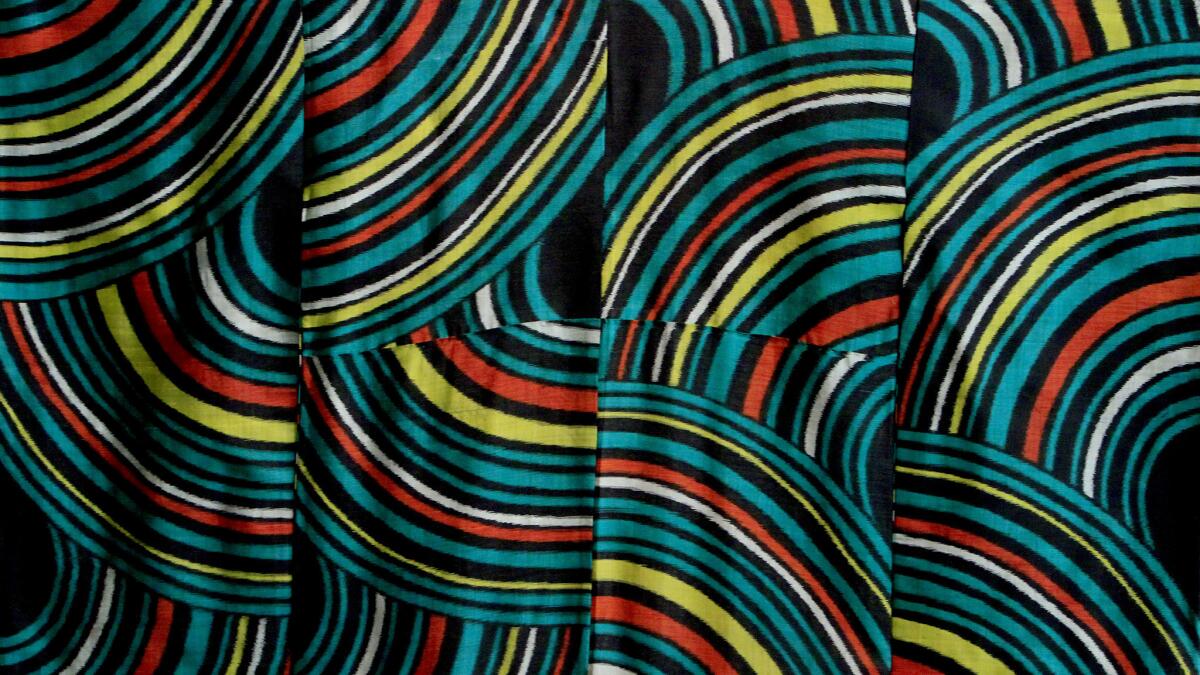From penguins to Sputnik: LACMA’s modern kimono show is off the hook

- Share via
Looping rainbows, twisting lines, wild mountainscapes, penguins on ice floes and even a Soviet satellite. I walked into the Japanese pavilion at the L.A. County Museum of Art the other day expecting an ethereal look at the world of the kimono. What I got was a face full of bold graphic design, geometric abstractions and blazing patterns. This was kimono like I’d never seen before.
This year, LACMA’s Japanese pavilion, one of L.A.’s more bizarre architectural wonders, celebrates its 25th anniversary. Designed by architect Bruce Goff in the early 1960s, it is a truly insane confection of curving ramps, stylized viewing alcoves, wall-to-wall carpeting and mint-green exteriors. It is one of my favorite spaces at LACMA, and it is usually empty.
But the pavilion’s current exhibition, “Kimono for a Modern Age,” is providing plenty of reason to head over to the museum’s more subdued east side. Organized by senior curator Sharon Takeda, the show features more than 30 kimono from the first half of the 20th century, when foreign design motifs and production techniques were making their way into Japan’s garment industry.
“We think we know kimono,” Takeda says. “But these blow people away because of their strong graphics.”
All of the kimono on view are from the 1920s to the 1950s and mark a time of great change in Japan: the rise of mass production and the adoption of fashions from abroad (in part, because of the U.S.’ post-War occupation of the country).
“This was a time when Japan came out of isolation,” Takeda says. “And you see designs that are influenced by what’s going on in the world: Art Deco and Art Nouveau (which is ironic, because Art Nouveau was inspired by Japanese art to begin with). This is also a time when the Imperial family starts to wear Western dress. At the time, kimono is still mainstream, but Western fashion is starting to penetrate.”
For the kimono, this led to a revolution in decoration (if not in form). German synthetic dyes were introduced, in addition to mechanical looms and faster, more cost-effective ways of producing pattern on fabric.
“Everything becomes less expensive,” Takeda explains. “And these become part of a more informal wear. They’re not ceremonial. They were affordable to all social classes, including working-class women. Wealthy women, who’d always had kimono, could now have more of them.”
As part of this, kimono designs react with greater speed to what is happening in the world. The exhibition contains kimono that commemorate Sputnik and Antarctic exploration. They reflect the blocky, Color Field elements of Modern design and the explosive splashes of Expressionist art.
Naturally, many women still wore traditional hand-crafted kimono spun from fine silk during the early 20th century. But with their bold colors and bright designs, these modern styles marked a historic break.
“It’s a time of cafes and bars,” says Takeda. “Music is a thing. Jazz is arriving in Japan. And this is the most fashionable, of-the-moment garment out there.”
“Kimono for a Modern Age” is on view through Oct. 19. 5905 Wilshire Blvd., Los Angeles, lacma.org.
More to Read
The biggest entertainment stories
Get our big stories about Hollywood, film, television, music, arts, culture and more right in your inbox as soon as they publish.
You may occasionally receive promotional content from the Los Angeles Times.











